I noticed the other day that my tankless hot water tank was occasionally spraying water all over the place from the Pressure Relief Valve. The only way I've found that seems to reliably trigger this is flushing the toilet, and turning the hot water in the bathroom sink off while it's still flushing. Sometimes it's only a drip, other times it's a violent spray of water that gets everywhere.
Potentially relevant information I can think of
-
The tankless was put in a few months ago, and I've never noticed water leaking before a couple of days ago. It's in the laundry room though, which I do not visit on a regular basis, so perhaps this has been happening longer?
-
Tankless is set to 120F ever since it was installed, and water temperature seems to be about that.
-
I'm in NY, where the weather has recently started getting cold
-
The plumbing in this house is really old, and in some cases looks like the previous owners did DIY plumbing
-
The toilet looks equally old. I've had issues with it flushing, flushing slowly, and clogging on a regular basis. I was considering replacing it because a plumber told me they thought it may just be the calcium(?) deposits built up in the piping over the years, causing it to have a really narrow hole.
-
The pipes go from the tankless in the laundry room, through the wall to the garage to where the old hot water tank sat (PEX pipes in garage), then metal pipes go from where the old hot water tank to the floor to run through the crawlspace to the water meter on the other side of the house. The majority of the water (kitchen and bathroom) are on the other side of the 1000sqft house.
-
The crawlspace is encapsulated (as of this summer), with the furnace venting down there. It should not get unreasonably cold, although a couple months ago a section of the metal pipe in the crawlspace did spring a leak and have to be replaced.
-
I have occasionally heard the toilet making weird noises, as if water is being forced into it. This is what makes me think it's an issue with the pressure and not related to a faulty valve.
- I just read this post about a tankless turning on while flushing. Mine does that too, so I am guessing there is a mixing valve somewhere down in the crawlspace or in the walls? I've never noticed any condensation on the toilet bowl, but only lived here since summer
I'm trying to figure out why this is happening, and what I can do to fix it. Get an expansion tank? Get a new toilet? Any thoughts or knowledge would be helpful.

Best Answer
Whenever a valve opens and closes, it causes a pressure spike. This is because water is incompressible, so it tends to telegraph pressure spikes a long distance.
Water has mass. When you open a valve, the water has to start to move. That causes a local low pressure area which of course is what makes the water move.
When you close a valve, a significant mass of water (in the pipe) is moving toward the open valve. The water at the valve must stop, but the water behind it is still moving toward it. So it is compressed. All the water's kinetic energy is converted to pressure, in a millisecond. The water moving toward the open valve seeks any possible outlet for the kinetic energy.
It finds the pressure relief valve in the water heater.
If it hadn't found that, it could break a pipe.
A related problem is when it finds an expansion tank on the other side of the water heater, or some comparable "place for the pressure to go". Thus the pressure is relieved by water moving through the water heater. The tankless sees this water movement, and turns on.
In a city water system, the obvious place this pressure can go is back out to the street - where it can be absorbed by the massive city water piping. This is rendered impossible if a check valve (aka backflow preventer) is added to the system.
An expansion tank is designed to create an outlet for such energy.